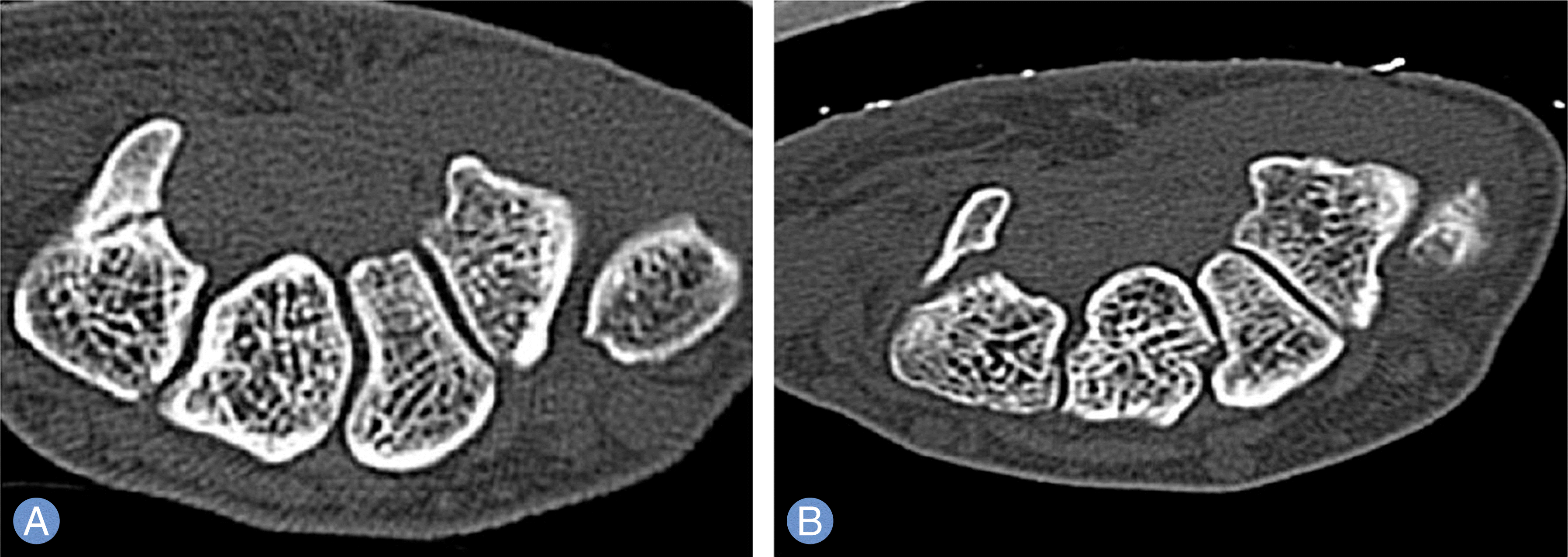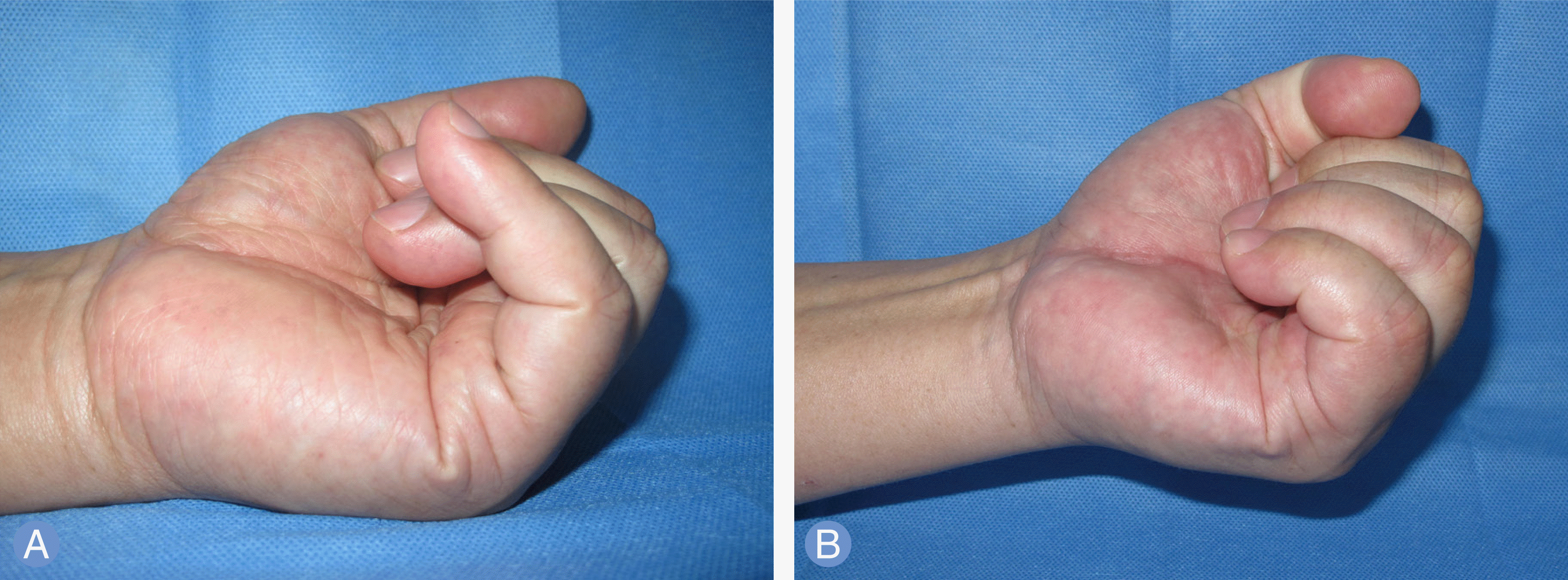Abstract
Purpose:
We report surgical results and the relationship between hamate hook fracture and flexor tendon rupture occurred during excessive golf practice or rounding.
Methods:
The 16 cases of patients with fracture of hamate hook or flexor tendon injury caused by golf swing were examined retrospectively. Hamate hook excision were underwent in fracture alone, flexor tendon reconstruction with tendon transfer of 3rd or 4th flexor digitorum sublimus (FDS) were done in the flexor tendon rupture. Postoperative results were evaluated by means of American Society for Surgery of the Hand (ASSH) to compare total range of motion and the grip strength.
Results:
The fracture gap was not far apart completely in computed tomography (CT) of hamate fracture alone cases. If the flexor tendon rupture with the fracture, the gap in CT was far apart completely. After flexor tendon transfer surgery, two cases were excellent, five cases were good, two cases were fair in ASSH assessment. One case was re-rupture. Grip strength as compared with the normal side was observed for the mean grip strength of 82% recovery.
REFERENCES
1. Takami H, Takahashi S, Ando M. Rupture of flexor tendon associated with previous fracture of the hook of the hamate. Hand. 1983; 15:73–6.

2. Parker RD, Berkowitz MS, Brahms MA, Bohl WR. Hook of the hamate fractures in athletes. Am J Sports Med. 1986; 14:517–23.

3. Hartford JM, Murphy JM. Flexor digitorum profundus rupture of the small finger secondary to nonunion of the hook of hamate: a case report. J Hand Surg Am. 1996; 21:621–3.

4. Crosby EB, Linscheid RL. Rupture of the flexor profundus tendon of the ring finger secondary to ancient fracture of the hook of the hamate. Review of the literature and report of two cases. J Bone Joint Surg Am. 1974; 56:1076–8.
5. Torisu T. Fracture of the hook of the hamate by a golfswing. Clin Orthop Relat Res. 1972; 83:91–4.

6. Nisenfield FG, Neviaser RJ. Fracture of the hook of the hamate: a diagnosis easily missed. J Trauma. 1974; 14:612–6.
8. Stark HH, Jobe FW, Boyes JH, Ashworth CR. Fracture of the hook of the hamate in athletes. J Bone Joint Surg Am. 1977; 59:575–82.

9. Carter PR, Eaton RG, Littler JW. Ununited fracture of the hook of the hamate. J Bone Joint Surg Am. 1977; 59:583–8.

10. Milek MA, Boulas HJ. Flexor tendon ruptures secondary to hamate hook fractures. J Hand Surg Am. 1990; 15:740–4.

11. Watson HK, Rogers WD. Nonunion of the hook of the hamate: an argument for bone grafting the nonunion. J Hand Surg Am. 1989; 14:486–90.

12. Yamazaki H, Kato H, Nakatsuchi Y, Murakami N, Hata Y. Closed rupture of the flexor tendons of the little finger secondary to non-union of fractures of the hook of the hamate. J Hand Surg Br. 2006; 31:337–41.

13. Imbriglia JE, Goldstein SA. Intratendinous ruptures of the flexor digitorum profundus tendon of the small finger. J Hand Surg Am. 1987; 12:985–91.

14. Riaz M, Hill C, Khan K, Small JO. Long term outcome of early active mobilization following flexor tendon repair in zone 2. J Hand Surg Br. 1999; 24:157–60.

15. Marks MR, Gunther SF. Efficacy of cortisone injection in treatment of trigger fingers and thumbs. J Hand Surg Am. 1989; 14:722–7.

16. Murray PM, Cooney WP. Golf-induced injuries of the wrist. Clin Sports Med. 1996; 15:85–109.
17. Mallon B. Biomechanics of the golf swing in players with pathologic conditions of the forearm, wrist and hand. Am J Sports Med. 1992; 20:99.

18. Palmer AK, Werner FW, Murphy D, Glisson R. Functional wrist motion: a biomechanical study. J Hand Surg Am. 1985; 10:39–46.

19. Minami A, Ogino T, Usui M, Ishii S. Finger tendon rupture secondary to fracture of the hamate: a case report. Acta Orthop Scand. 1985; 56:96–7.

20. Xiong G. Hook of hamate fractures: location and tendon rupture. J Hand Surg Am. 2014; 39:175–6.
21. Brand PW. Clinical mechanics of the hand. St. Louis: Mosby;1985.
Fig. 1.
(A) The zigzag incision on the palm to avoid median and ulnar nerve injury and to find out proximal stump of ruptured flexor tendon as well as hamate hook fracture. (B) Fracture fragment was excised from the hamate. (C) View of ruptured 5th flexor digitorum profundus (FDP). (D) The periosteum over the hook site was repaired to construct a smooth tunnel floor over the base of the excised hook. (E) 1 cm-transverse incision was made over volar digitopalmar crease and 4th flexor digitorum sublimus (FDS) was divided. (F) Then 4th FDS was sutured to the distal 5th FDP using a Pulvertaft interweaving technique.

Fig. 2.
Comparative computed tomography scan images of (A). Hamate hook fracture only and (B). Hamate hook fracture with flexor tendon rupture. Note the gap of fracture completely in B.

Fig. 3.
Preoperative and postoperative clinical photographs. (A) Preoperative photographs showed inability to flex small finger. (B) Postoperative photographs showed nearly full flexion of the small finger.

Table 1.
Demographics of the Patients with hamate hook fracture or flexor tendon rupture
| Patient | Age (yr)/ Sex | Handicap | Time from Injury to surgery (mo) | Hamate fracture | Tendon rupture (involved tendon) | Reconstruction | Final results* |
|---|---|---|---|---|---|---|---|
| 1 | 46/male | 80 | 7 | Yes | No | - | - |
| 2 | 49/male | 80 | 5 | Yes | No | - | - |
| 3 | 42/male | 90 | 4 | Yes | No | - | - |
| 4 | 49/male | 90 | 4 | Yes | No | - | - |
| 5 | 52/male | 80 | 3 | Yes | No | - | - |
| 6 | 51/male | 80 | 3 | No | Yes (5th FDP) | 4th FDS →5th FDP | Good |
| 7 | 38/male | 90 | 1 | No | Yes (5th FDP) | 4th FDS →5th FDP | Good |
| 8 | 52/male | 80 | 3 | No | Yes (5th FDP) | 4th FDS →5th FDP | Good |
| 9 | 47/male | 90 | 4 | No | Yes (5th FDP) | 4th FDS →5th FDP | Excellent |
| 10 | 46/male | 80 | 3 | Yes | Yes (5th FDP) | 3rd FDS →5th FDP | Excellent |
| 11 | 54/male | Unknown | 6 | Yes | Yes (5th FDP) | 4th FDS →5th FDP | Fair |
| 12 | 45/male | 80 | 3 | Yes | Yes (4th FDP†, 5th FDP) | 4th FDS →5th FDP | Good |
| 13 | 54/male | 100 | 2 | Yes | Yes (4th FDS†, 5th FDP) | 4th FDS →5th FDP | Good |
| 14 | 55/male | 80 | 5 | Yes | Yes (4th FDP†, 5th FDP) | 4th FDS →5th FDP | Fair |
| 15 | 62/male | 70 | 1 | Yes | Yes (4th FDP†, 5th FDP) | 3rd FDS →5th FDP | Rerupture |
| 16 | 59/male | 80 | 7 | Yes | Yes (4th FDS†, 5th FDPf) | Debridement | |
| Mean | 50 | 83 | 3.8 |
Table 2.
American Society for Surgery of the Hand grading for flexor tendon assessment (sum of the degrees of active metatarsophalangeal, proximal interphalangeal, distal interphalangeal joint flexion)
| Assessment | Total active motion (% of corresponding contralateral digit) |
|---|---|
| Excellent | 257°< (100) |
| Good | 195°–257° (75–99) |
| Fair | 130°–194° (50–74) |
| Poor | <129° (50) |




 PDF
PDF ePub
ePub Citation
Citation Print
Print


 XML Download
XML Download